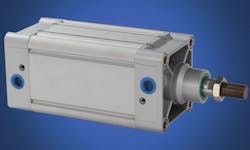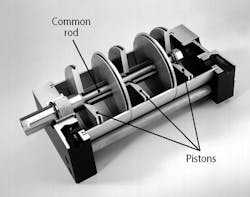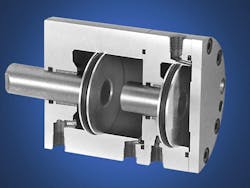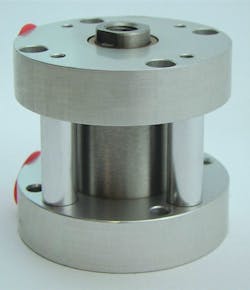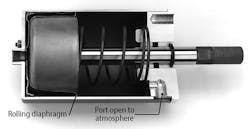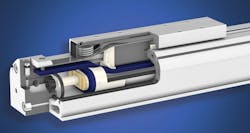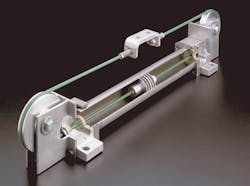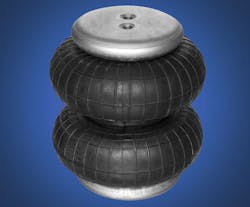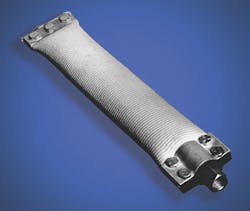Air Cylinders Offer Variety and Versatility
Hydraulic cylinders may provide plenty of muscle and precise positioning for heavy industry and off-highway equipment, but air cylinders come in a wide array of specialty designs and configurations—making it a cinch to solve challenging applications that even some custom-made conventional cylinders can’t.
Like all cylinders, these specialty cylinders use pressurized fluid (air, in this case) to produce linear motion and force to move, push, or pull a load. But compressed air generally exhibits pressure of about 100 psi—a fraction of that used in hydraulics. This means an air cylinder would need a large bore to transmit high force. But at least one design of specialty air cylinder uses more than one piston to multiply force from a given bore.
Tandem cylinders use multiple pistons connected through a common rod to generate relatively high force from a low supply pressure.
Called tandem cylinders, they use two or more pistons connected to a single piston rod to multiply force produced by a cylinder without increasing bore size. This makes tandem cylinders ideal for applications where high force must be generated from a smaller bore than a standard air cylinder could have.
A deviation from this is a duplex cylinder, which contains two pistons, but each is connected to a separate, inline piston rod. This configuration can produce motion with two different stroke lengths. With both pistons retracted, one stroke is accomplished by energizing the cylinder chamber opposite the rod end. A second stroke occurs by energizing the chamber closed to the rod end. The net result is a cylinder that produces three distinct positions with having to use complicated switching or external stops.
Duplex cylinders have multiple pistons that are not connected to a common rod. Actuating individual piston chambers achieves multiple strokes.
Many applications, however, require high force but a relatively short stroke. These applications are well-suited to short-stroke cylinders, which generally have a rod length less than the piston diameter. They are also used where high force must be generated from a relatively low supply pressure. Short-stroke cylinders fit into a narrow axial space but require substantial radial width.
Short-stroke cylinders have a piston diameter that exceeds rod length. They are used where axial space is limited and high force must be generated from a relatively low supply pressure.
Diaphragm cylinders are either of the rolling diaphragm or the short-stroke type. Both use elastomeric diaphragms to seal the barrel-piston interface. The short-stroke type uses an elastomer sheet secured between halves of the cylinder body and is commonly used in air brake applications for trucks, buses, and other heavy vehicles.
By eliminating the conventional sliding piston seal—and its inherent tendency toward stick-slip operation—diaphragm cylinders produce nearly frictionless motion. The diaphragm’s positive sealing also eliminates the potential for leakage around the piston.
The rolling diaphragm cylinder uses a hat-shaped diaphragm that rolls into the cylinder barrel as the piston advances. Because they have no dynamic seals, both types exhibit very low breakout force, have zero leakage, and are single-acting, spring returned. The rolling-diaphragm design, however, is available as a double-acting cylinder. A second rolling diaphragm is used instead of a spring to retract the piston.
Less Space, Longer Stroke
Designers continue to look for ways to more with less, especially making machines smaller by specifying more-compact components that don’t compromise performance. This the driving force behind the increasingly widespread use of rodless cylinders.
Rodless cylinders are sized by bore and stroke but by not having a piston rod. Their extended length is a little more than half the length of a conventional cylinder. Three main designs of rodless cylinders are common—the piston-lug version, the cable cylinder, and the flexible-wall cylinder. Most of these are designed for use with pneumatics, but some manufacturers provide ratings for low-pressure hydraulic service.
The piston-lug design works in a fashion similar to that of a conventional cylinder but does not move the load through a rod. Instead, a stud extends from the side of the piston out through a longitudinal slot in the barrel. A drive lug is attached to the end of the bolt and moves directly with the piston.
The piston-lug rodless cylinder drives the load by a lug connected to the piston by a bolt that protrudes through a slot in the barrel. A seal running along the length of this slot prevents compressed air from leaking as the piston and lug traverse the stroke.
To seal the slot between the piston and lug, steel bands pressing against each other separate when the stud passes by. Different piston widths are available to meet any bending moments imposed by a load. Stroke lengths of piston-lug cylinders can exceed 30 ft. Options include position switches, brakes, and carriages to support loads and maintain alignment.
A variation of the piston-lug cylinder uses a permanent magnet in the piston to create a magnetic field that links the piston to the lug through the cylinder barrel. This eliminates the need for a longitudinal slot in the barrel and, therefore, the need for any dynamic seals. Breakaway forces of the magnetic field can exceed 200 lb. As with diaphragm cylinder, the absence of dynamic seals means the magnetically coupled rodless cylinder can hold pressure (therefore, the load) indefinitely—at least theoretically.
Magnetic coupling of the piston to the lug allows this rodless cylinder to drive and position loads without using any dynamic seals.
In a cable cylinder, as the piston moves inside the cylinder barrel, it pulls a cable attached to both sides of the piston. The cable wraps around a pulley mounted at each end and attaches to a yoke. As the double-acting piston moves in one direction, the yoke travels in the opposite direction because of the wrap around the pulleys.
This cutaway of a cable cylinder shows how the piston is connected to the yoke through a cable assembly. This design uses a seal around the cable where it passes through each end cap.
Options include automatic cable tensioning, single-acting models, cable tracks for greater load stabilization and capacity, a pulley arrangement to double the stroke and speed, caliper disc brakes on the cable pulley, and reed switches. The cable also can be wound around a drum to provide rotational motion.
A variation of the cable cylinder relies on a metal band running over pulleys instead of a cable. Each end of the upper yoke rides on the cylinder barrel for greater load stability and capacity, negating the need for a separate load carriage in many applications. These cylinders may be fitted with a brake that stops and holds the load anywhere along the stroke.
Flexible cylinders have evolved from designs that were originally made for vibration and isolation mounting. They consist of metal mounting plates fixed to a reinforced rubber chamber that extends and collapses, respectively, as it is pressurized and vented. They have generous lateral misalignment allowances and can actuate through an arc without a clevis mount.
Flexible cylinders provide linear actuation without any dynamic seals. The type shown has two flexible chambers, expand axially when pressurized.
Some precautions should be exercised when applying these cylinders. First, mechanical stops should be provided to limit the length of extension. Otherwise, an overrunning load could pull an end plate off the cylinder. Mechanical stops should also limit retraction, thereby preventing crushing the elastomeric portion of the cylinder between end plates. Alignment of these cylinders is much less critical than with conventional cylinders. However, relative torsional rotation between the end caps should be prevented to keep from having the elastomeric portion fail due to excessive shear stress.
The hose-type cylinder expands radially when air is introduced. This type is best suited for short-stroke applications where actuation must occur over a relatively long length, especially when minimal clearance is available.
An alternate design resembles a length of flexible hose sealed at both ends. With no pressure, the hose is flat; pumping air into it expands the hose into a tubular shape. Maximum stroke is approximately the ID of the inflated hose. Using a long length of such hose can generate very high force from a relatively low pressure. However, actuation force decreases with extension length. This is because as the hose expands, it becomes more circular, so a smaller area is in contact with the load to apply the force.
